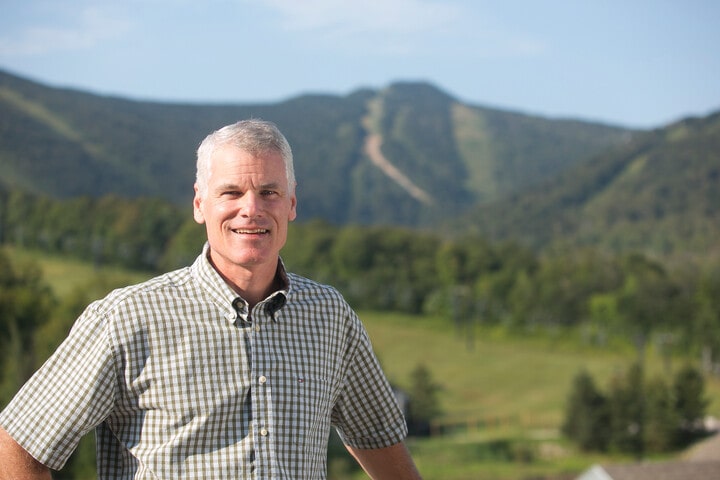
Facing a standing-room-only crowd of over 700 on October 9, Mike Solimano, President and CEO of Killington and Pico Ski Resorts presented the annual season update to an attentive crowd of locals and second homeowners. A month earlier, the stunning news that Killington and Pico had been sold to a group of local private investors had broken and anticipation for what this meant for the future of the two resorts was high. After 40 years, Killington would no longer be part of a conglomerate and was returning to local, independent ownership. Mountain management was excited and new marketing materials extolling Killington’s reputation as the “Fiercely Independent Beast of the East” had already been developed and distributed. Killington locals were hoping for the best, that is, news that old lifts would be replaced, snowmaking updated, and the longstanding policy of opening early and closing as late as possible would remain front and center as the Resort navigates the future. As the meeting progressed, they were not disappointed. Killington is embarking on a new chapter that will include significant growth while retaining the policies that made it one of the premier ski destinations in the Northeast.

In 1954, Preston Smith worked with Perry Merrill, Vermont’s State Forester, to lease State land on Killington Peak to develop a ski resort. Smith worked for four years to amass enough investors, forming the Sherburne Corporation. The State began construction on Killington Road in 1957. Upon completion, Smith and his team cut the initial trails and lift lines on the face of Mt. Killington; they also created a parking lot and a site for a lodge. Killington Basin Ski Area opened on December 13, 1958.
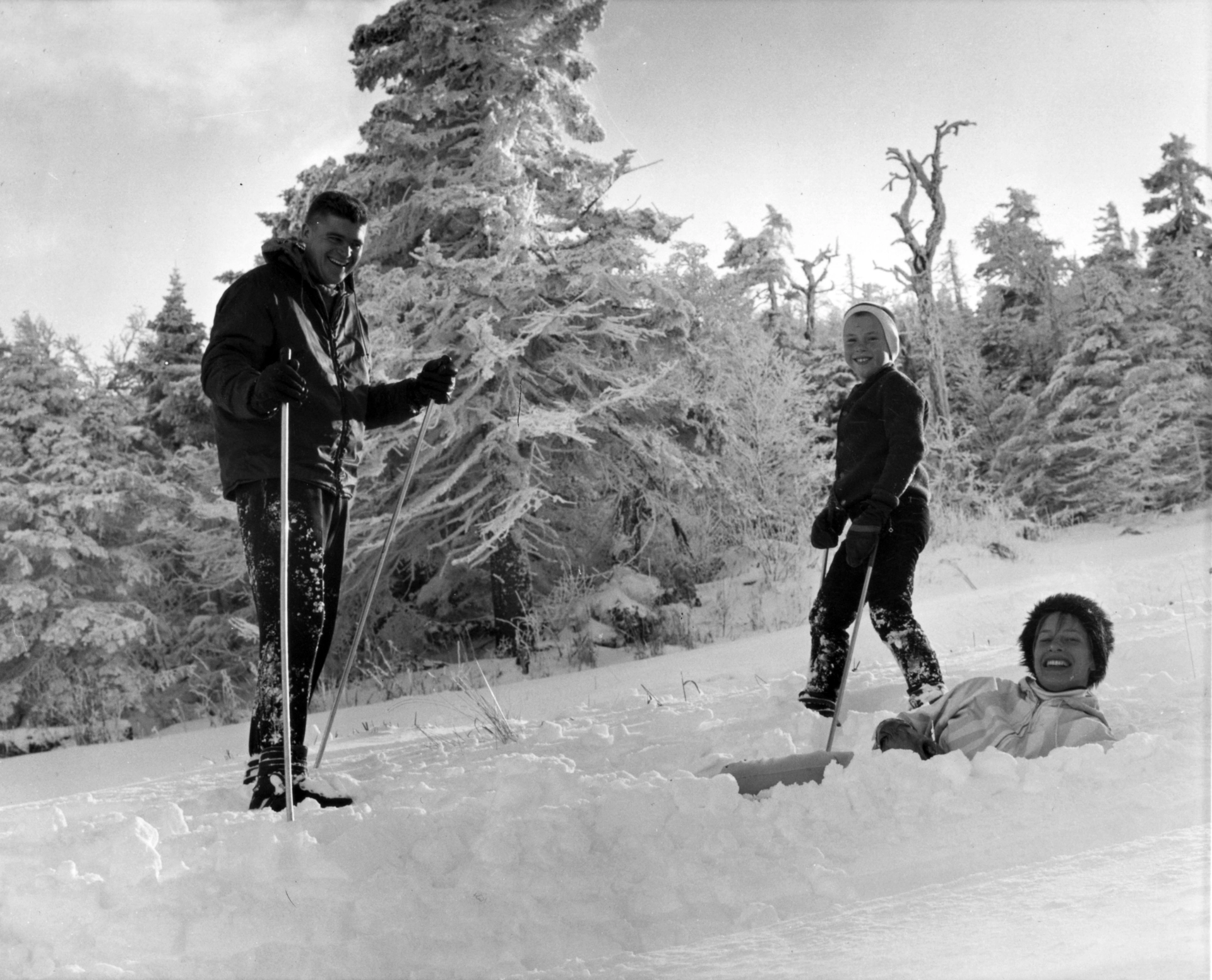
Two years later, the ski area installed the 6,300-foot Killington double chairlift that reached Killington’s summit and it cut three new trails. During the 1962-63 season, beginner terrain was added and advances in snowmaking technology were made. The Snowshed chairlift was installed and operations expanded to North Peak, which was soon renamed Ramshead. These easier slopes enabled new skiers to learn the sport. Smith insisted a beginner trail be provided as a way down from every chairlift, including the Great Northern that ran from the peak of Killington to the base lodge.
By the middle of the decade, Killington had grown quickly. Aside from its first year of operation, the Resort made a profit every year. It also expanded its terrain to include Snowdon Peak. Revenues reportedly reached $1 million for its 183-day season, from mid-November to mid-May.
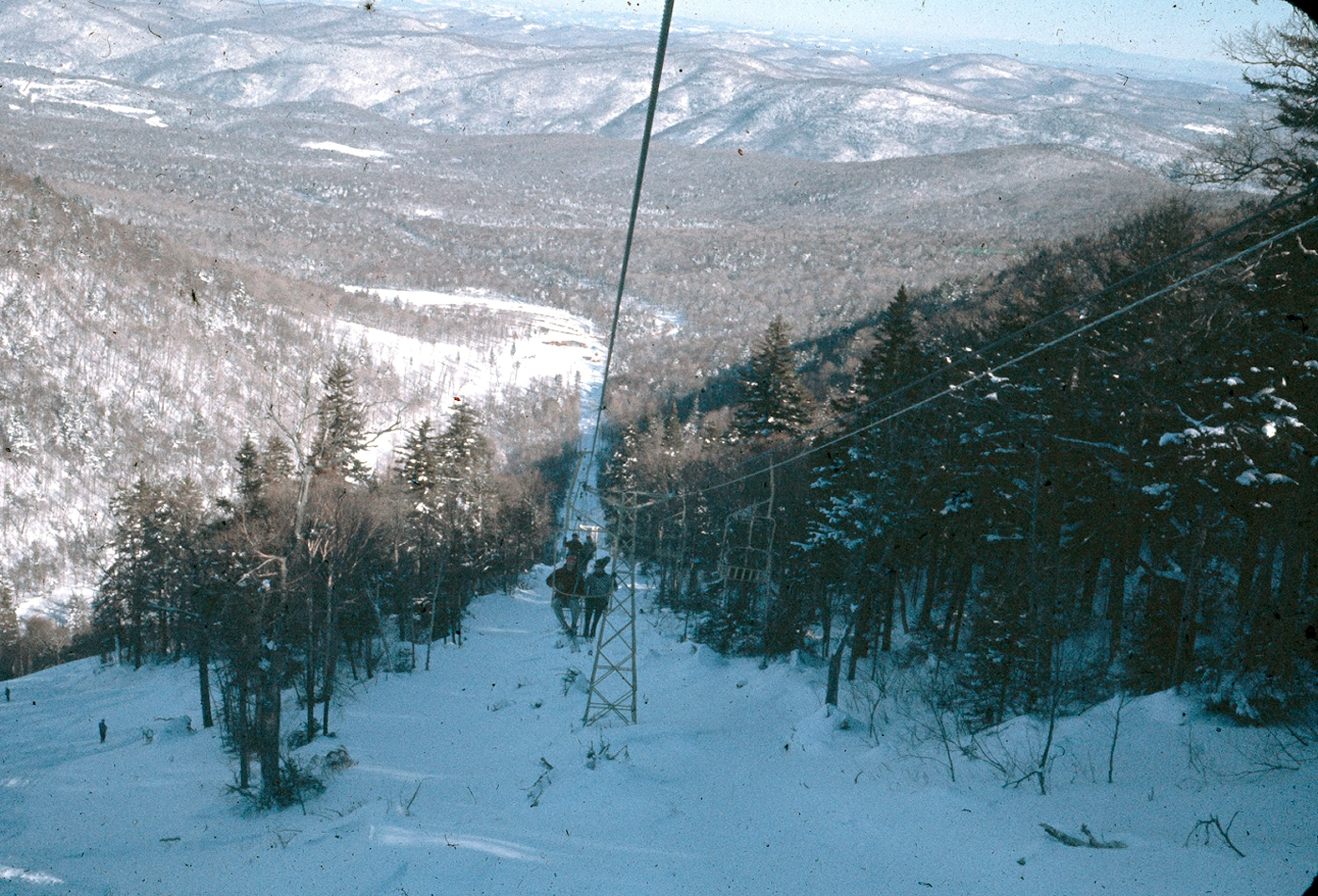
The resort continued to expand during the ‘70s, adding Killington East making it Vermont’s largest ski resort. After several years of construction, a new gondola running from Route 4 to Skye Peak opened. This lift serviced Great Eastern, a five-mile ski run, and offered a 3,000-foot vertical drop. Snow guns were added to upper mountain trails. Killington introduced a ski school for instructors, added a cross-country ski program, and upgraded to chairlifts replacing the original surface Poma lifts. In 1973, the energy crisis, inflation, and political opposition towards ski area expansion caused the resort to lose money for the first time. It was not long before the resort recovered, largely by expanding its summer business with features such as tennis courts, ponds, and hiking trails. Killington continued to expand with the addition of trails and lifts on Ramshead Mountain, Skye Peak, Bear Mountain, and Sunrise Mountain. In 1984, Killington’s parent company, the Sherburne Corporation, was restructured as S-K-I Limited; it now owned Sunday River in Maine and Mount Snow in Vermont, as well.

The now-defunct American Skiing Company (ASC) purchased Killington Resort from S-K-I Limited for $137 million in February 1996. The new ownership completed several capital improvements, including swapping the old Killington double chair for a new gondola in 1997. ASC sold Killington and Pico to SP Land Company on May 11, 2007, for $85.2 million, with Powdr Corporation taking over operations. POWDR, which owns multiple ski resorts, invested in new lifts, lodges, and snowmaking. The Skye Peak Express Quad opened for the 2008-09 season. In 2010, the Peak Walkway was installed; early season snowmaking on Northridge could now be accessed on foot from the top of the K-1 Gondola. Powdr oversaw the building of two new lodges: the Peak Lodge which opened for the 2013-14 season, and the new $30 million base lodge which opened for the 2022-23 season. The 58,000-square-foot structure includes seating for 950 guests and 180-degree views of the mountain.
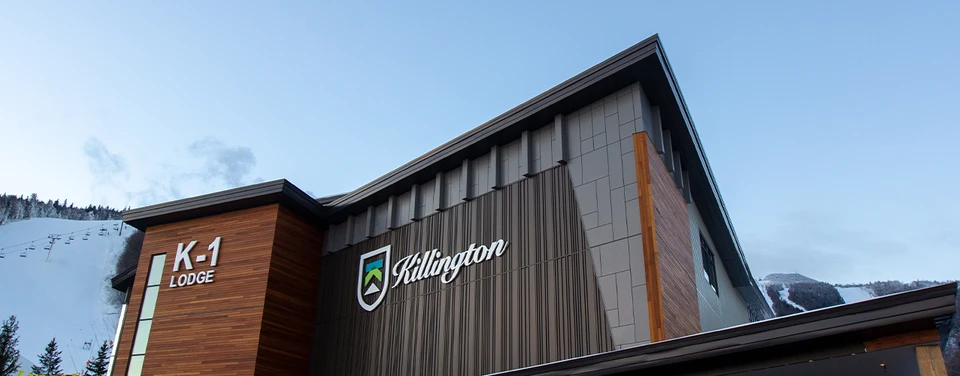
POWDR Corp continued to make major capital improvements to Killington investing $25 million. These included the Snowdon Six Express, a high-speed six-pack with a bubble, several tunnels to improve skier flow at busy intersections, converting the North Ridge triple to a quad, and the addition of the South Ridge quad. The resort also upgraded to an RFID ticketing system. Killington expanded its focus on year-round activities beginning in 2014 with the addition of lift-served mountain biking at Snowshed; subsequent expansions to the Ramshead chair and the K-1 Gondola increased the number of trails and scope of riding for visitors. The Adventure Center began to take shape in 2015, with the addition of the Skye Ropes Course, Soaring Eagle, and Beast Mountain Coaster.
Powdr sold the resort to the Killington Independence Group LLC, represented by lead investors Phill Gross and Michael Ferri in the fall of 2024. The Group is comprised of local homeowners, Powdr (who retains a minority ownership), and Great Gulf (the developers chosen to build the new village). The final sale price was not disclosed.
Powdr is selling certain ski areas to diversify its business. It will be expanding its National Parks concessions division launched earlier this year at Death Valley and it will continue to promote its Woodward brand. “This move complements our existing mountain resort operations at Snowbird and Copper, creating a diverse ecosystem of outdoor and action-sports experiences,” POWDR CEO Justin Sibley said in a statement provided to The Storm: “By balancing the seasonality of our traditional ski resorts with year-round attractions like Woodward and National Park concessions, we’re building a more resilient and dynamic company.”
Killington Ownership History
| Year | Ownership Entity | Notes |
| 1954 | Sherburn Corporation (Preston Smith) | Initial Development |
| 1984 | S-K-I Limited (Preston Smith) | Sherburne Corporation a publicly traded was renamed S-K-I Ltd. (Sherburne-Killington-Investments) and became a Nasdaq-listed company. |
| 1996 | American Ski Company | Originally LBO Resort Enterprises Corporation |
| 2007 | Powdr Corporation | Park City-based conglomerate |
| 2024 | Killington Independence Group, LLC | Killington Independence Group LLC lead investors: Phill Gross and Michael Ferri.
The group also includes: Jim Bianchi and the LEGS Fund; The Morse family; Mike and Christina Gordon; The Buck family; Alex and Mimi Rozek; Simon and Kevin Yates; Matt Strobeck, Carey Strobeck, Delta Properties, and their business partners Rob Cone and Andrew McNealus; Peter Nassif; Adam Winkel; Brad Paul; Mike Hone; Scott Halpern; Jason Schwartz; Nick Leeper; Powdr; and Great Gulf. |
At the annual Killington Update Meeting on October 9, Mike Solimano disclosed that Alterra tried to buy Killington first, but the deal fell apart. There was concern that given the mountain’s popularity, the crowds associated with being an unlimited Ikon resort would result in crowds that would be too large and disruptive. Killington will remain on the IKON pass. Phill Gross explained how he was approached by Powdr. The story started not with this sale, but with the start of Powdr’s ownership of Killington in 2007 when it planned to shut down the Skyeship Gondola, which is known for its long run, The Great Eastern. Gross owned a trailside house on Great Eastern and was a big fan of the run: he reached out to John Cumming, Powdr’s founder and former Chairman, to protest the move. This resulted in several meetings between Gross, Cumming, and management from Killington and Powdr. They ultimately resolved to keep the gondola open and these meetings allowed Gross and Cumming to get to know each other. After the Alterra deal fell through, Cumming personally reached out to Gross and offered him the opportunity to buy the mountain.
Gross thought it might be too difficult to do, but he contacted his friend Michael Ferri who was enthusiastic about the possibility telling him that “they would have to try and do it.” Both men set about raising the needed capital. They also hired an independent firm that specializes in ski resorts to vet Killington’s management quality; the company informed them that the mountain’s management team was one of the best in the business. Gross and Ferri are keeping the team intact and will not be involved in the day-to-day running of the resort. “We’re going to let them run the mountain,” said Gross at the meeting. “We’re not going to get involved in anything other than giving them and the community the resources they need to improve the mountain and make it the best it can be,” he added. The two men will chair the Board of Directors. When the potential sale became public in late August, they were approached by additional investors who wanted to participate. They ended up having access to more money than they needed. They turned away the majority of people who wanted to invest. The biggest aspect of the sale is that they could do it with no net debt, and 100% equity. The new ownership group bought all assets and it owns everything both on and off the mountain that Powdr owned. No one member of the ownership group has more than a 20% stake.
Killington Board of Directors
| Member | Description |
| Phill Gross | KMS* Board Member, Homeowner since 1972 |
| Michael Ferri | KMS Board Member, Homeowner since 1972 |
| William Buck | Homeowner since 1993 |
| Michael Morse | KMS Graduate/Olympic Mogul Competitor |
| Tim Brennwald | Chief Operations Officer, POWDR |
| Michael Syned | President, Resort Division, Great Gulf |
| John Casella | Director, Casella |
| Michael Hone | KMS Board Member |
| Carolyn Kepcher | Owner, Snowed Inn |
*Killington Mountain School
Powdr stipulated that they could not sell the Resort for 10 years. Both Gross and Ferri indicated they had no problems with the clause and the new ownership group plans to reinvest all profits back into Killington and Pico to revitalize infrastructure and transform the resorts. Powdr continues as a minority investor and retains a seat on the Board of Directors. Given Powdr’s investments in Killington, combined with the long-term plan to build a village at the base of the mountain, it sees the value in remaining involved with both Resorts.
While most of the focus has been on Killington, Pico will also benefit. The new ownership team is committed to maintaining and improving Pico. While there has been a push to physically connect the two resorts, they plan to keep Pico separate from Killington for the time being. Pico will continue to benefit from reinvesting the season’s profits back into the resort; this policy started a few years ago when Solimano and his team decided to close the Resort for two days mid-week due to low traffic. This allowed Powdr to save money to reinvest in the area. An example of how Pico makes additional money while the hill is closed can be found in the decision to rent the mountain out to private groups for approximately $10,000 per day. This has been successful and the mountain has been booked each year for the allotted number of days slotted for this initiative.

It was Smith’s vision to build a village at the base of Killington; that was never realized due to the inability to get the needed water infrastructure up to the mountain approximately five miles off US RT 4. The project is complicated requiring the coordination of private and public funding while meeting the regulatory requirements of Vermont’s Act 250. Killington’s Six Peaks Ski Village is being developed by the residential division of the Great Gulf Group of Companies, headquartered in Toronto, Canada. Great Gulf bought the rights and permitted plans to develop the village from SP Land Co for $43 million in May 2023.

The planned village will be at the base of Snowshed and Ramshead on 1,095 acres of land that will contain commercial and residential space; the village portion will be on 45 acres. At the October 9 meeting, Michael Sneyd, President of Resort Residential at Great Gulf, said the first phase of the village will include 650 ski-in/ski-out condominiums, single units, and townhomes at Ramshead, over 110,000 square feet of retail and dining, an 85,000 square foot ski lodge, two public squares, and a waterfront promenade. Sneyd also discussed future ideas for a farm-to-table greenhouse/garden, a canopy boardwalk, and nature play structures for children.
There are “two significant gathering areas,” Sneyd explained. “The Main Town Square in the middle of the village and the Snow Beach Square that celebrates the biggest ski beach in the East.” The ski beach connects the Snowshed lift and the Ramshead lift. “And it’s flat the whole way,” Sneyd explained. Killington Road will be routed underneath it and the skiers will go over it on a wide, flat bridge. “The village will be a hub of activity,” said Mike Solimano. “Whether it’s something like ice skating or concerts, this will give people in the area a great place to come together and hang out, not to mention improving the availability of real estate and infrastructure in the Killington region,” he added.
While the new plans will be subject to an Act 250 review, permit approvals, water, and road infrastructure progress will be evident this winter and spring. Act 250 is a development review process by the State to ensure that projects “complement Vermont’s unique landscape, economy, and community needs.” Great Gulf is working to finalize Act 250 permits for stormwater reconfiguration at its new parking area and stormwater pond. It hopes to secure these soon to begin clearing trees in the approved Ramshead neighborhood this winter. The Town of Killington and Great Gulf are also working on the necessary permits and easements to build out Road H this spring, which will intersect the new parking areas along Killington Road and connect with Old Mill Road and East Mountain Road. The first phase of road and water infrastructure work started in May and has been completed.

Sneyd said that they plan to finalize its village architectural plans and get them to the Town’s Development Review Board in the first half of 2025 and then submit its Act 250 application in the second or third quarter of 2025. Great Gulf estimates it can begin selling units in the third and fourth quarters of 2025, and that building could start as soon as the second quarter of 2026. “We’re still on track to having the first occupancy before the 2027 ski season,” Sneyd said.
The development of Killington Village is complicated, requiring cooperation between the Town of Killington, the Resort, Great Gulf, and the State. The development could not have happened without local support that was codified in the Killington Forward Initiative (KFI), a comprehensive plan to develop municipal water infrastructure bringing water to the top of Killington Rd for the development of the village and bringing water down to improve water quality for properties with contaminated wells due to Per- and poly-fluoroalkyl substances (PFAS). It also includes a newly designed and rebuilt Killington Road with significant enhancements, workforce housing, and the Six Peaks Ski Village.
KFI will be financed through: Tax Incremental Financing (TIF); the American Rescue Plan Act (ARPA); the State Revolving Fund; a Northern Border Regional Commission (NBRC) Catalyst Grant; a Community Recovery and Revitalization Program grant; and USDA Rural Development financing. TIF requires local taxing bodies to make a joint investment in the development or redevelopment of an area, with the intent that any short-term gains be reinvested and leveraged so that all taxing bodies will receive larger financial gains in the future. The funds for this investment come from future tax revenues generated by increased public and private investment in an underperforming area. The Catalyst Grant Program is designed to stimulate economic growth and inspire partnerships that improve rural economic vitality across the four-state NBRC region. NBRC encourages projects that take a creative approach to addressing an economic need or opportunity in the region, alleviate economic distress, and contribute to economic growth.
December 2023 Funding total: $53.2 Million
| Total loans | Amount |
| Road Loans | $18.8M |
| Water Loans | $15.3M |
| Total Grants | Amount |
| Emerging Contaminants Forgivable Loans | $7.6M |
| ARPA Grants | $6.3M |
| NBRC Catalyst Grant | $3.0M |
| State Revolving Fund Loan Subsidy | $1.2M |
| Community Recovery and Revitalization Program | $1.0M |
The Town was awarded an additional $25 million by the U.S. Department of Transportation (USDOT) in June 2024. According to a June 26 letter to the Town from USDOT, the funding will be put toward safety improvements at intersections and where people cross the road. It involves 2.7 miles of shared-use path, 1.4 miles of new sidewalk, new stormwater infrastructure, and a rebuilt road. Funds are from the Rebuilding American Infrastructure with Sustainability and Equity (RAISE) grant program. Town Manager Michael Ramsey said the funds will be for phases two through four of the KFI. “It’s pretty clear that this project is quickly becoming an economic engine for our entire region. I think it’s probably safe to say that we’re going to be talking about this for generations to come. Things don’t happen this fast, normally. It is remarkable that the amount of energy that the Town is putting into making this public-private partnership work,” said Lyle Jepson, executive director of the Chamber & Economic Development of the Rutland Region.
KFI lists four distinct phases for both the road and water work that must be done. Phase one has been approved by voters and construction started this past summer and is slated to be completed by 2026. Phases two to four require review and approval by the Selectboard, the Vermont Economic Progress Council, and local voters.
During the October 9 meeting, Solimano discussed the $30 million worth of capital improvements for Killington and Pico slated to take place over the next 16 months. Being independent will invariably help keep profits locally. If the resorts were still owned by Powdr, profits from Killington and Pic would go to headquarters and might be invested elsewhere. Under the new independent ownership, all profits will be reinvested at Killington and Pico. Part of the exciting reinvestments will be a replacement of the Superstar Express Quad lift with a six-person Doppelmayr UNI-G lift—the first of its kind at Killington—with construction starting in April 2025; the estimated cost is $12 million. The new lift won’t include a bubble due to storage challenges and the relatively quick ride (approximately 7 minutes). “Upgrading to a six-person chairlift is mostly about comfort,” says Solimano. “We want to provide the best possible experience for our guests, so this new, roomier lift made a lot of sense. The heavier chairs also help with the wind, which is a bonus.” While the new lift will follow the same line as the current one, there will be some changes; all lift towers will be relocated except the main terminal towers. Snowmaking pipelines will be modified and there will be a new maintenance workshop built at the top of Skye Peak to support ongoing operations.

The Resort plans to focus snowmaking on the Northridge, Canyon, Snowdon, and Ramshead areas for spring skiing in 2025 since Superstar will not be available. Killington remains committed to having the longest season in the East. In response to questions from SnowBrains, Amy Laramie, VP of Brand Marketing and Events, wrote, “The mountain still plans on selling the popular spring pass, but details about the pass are still to be determined.”

The Skyeship gondola, which starts on RT 4 and terminates at the summit of Skye Peak, will get 116 new cabins during the summer of 2025. A new gondola storage barn will be constructed “in future years” according to Solimano. The new cabins will be similar to the current K-1 Gondola cabins.

Solimano’s team is also redesigning Pico’s Bonanza beginners’ area. They plan to install a magic carpet pending lift approval from the permitting process and are working collaboratively with Vermont Adaptive to enhance programming and opportunities. In a statement to The Mountain Times, Erin Fernandez, executive director for Vermont Adaptive Ski & Sport, said: “There are no words that articulate how positively significant it will be for our programs, our adaptive snow sports instructors, and participants with disabilities. Vermont Adaptive is so very appreciative that this project is being prioritized.”
The Resort will continue investments to upgrade its snowmaking capabilities by investing $7 million in 1,000 new snow guns over the next two seasons, replacing its old K 3000 guns. The new system uses 50% less diesel fuel and costs $3.35 per hour to run, resulting in a savings of $16.06 per hour compared to the older K 3000 guns. The 964 tower guns will more than double the number of guns at Killington and Pico to 1,695 and give the Resorts 2,459 guns for the 3,500 hydrants at the two ski areas. This year’s allotment for Killington will include 36 HKD Snowmakers Phazer portable guns and 454 HKD Impulse and Phazer R5 tower guns. For the 2025/26 season, there will be 510 new HKD Impulse and Phazer R5 tower guns installed at Killington.
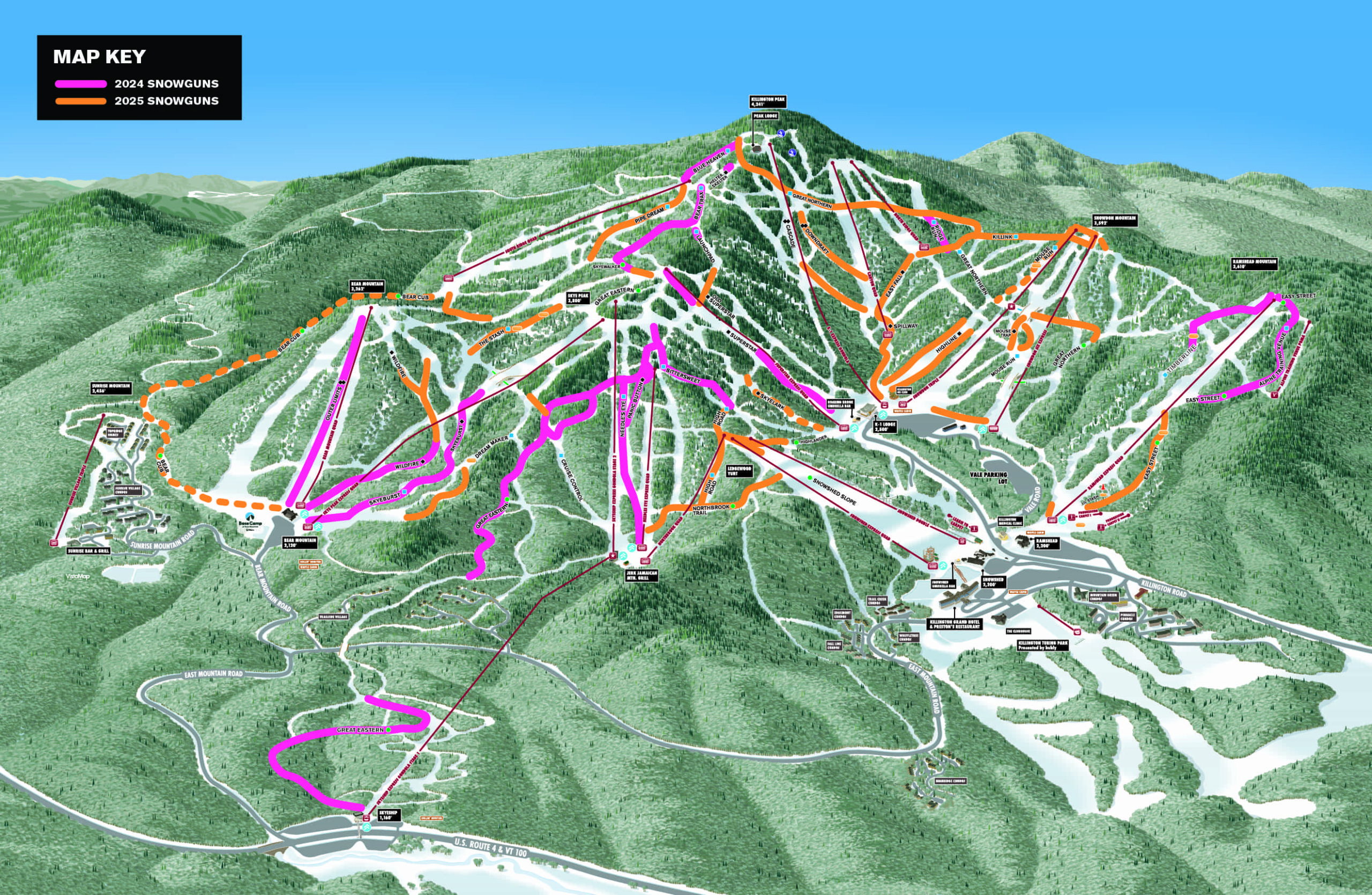
Killington has invested $6 million in upgrading Pico’s water access and snowmaking capability. In the past, snowmaking at Pico was constrained due to the size of their pond. It installed a new pipeline from Killington to Pico to increase the water available for snowmaking. During the 2023-24 season, Killington made eight water transfers to Pico, totaling 30 million gallons; Pico needed a total of 57 million gallons of water for their seasonal snowmaking. Pipes were updated on A and B Slope, and new pipes were installed on Bonanza. A new pump house was built to handle the expanded capacity. Pico will also receive 44 new tower guns for the 2024-25 season, which will double the number of its low-energy guns.
For the 2025-26 season, Killington will transition to a new control and hydrant tracking system, HKD ISno and HKD’s hydrant tracker, to monitor production and automate controls to ensure maximum snowmaking efficiency at both areas. “This is the most transformative snowmaking project since Killington expanded over to Bear Mountain in the late ’70s,” Killington snowmaking manager Greg Gleason said in a statement. “It’s great to see the resort investing in low-energy snow guns. Not only will it save on costs, it will allow us to expand terrain at a much faster rate in the early season, while still providing a quality product to our guests,” according to Gleason.
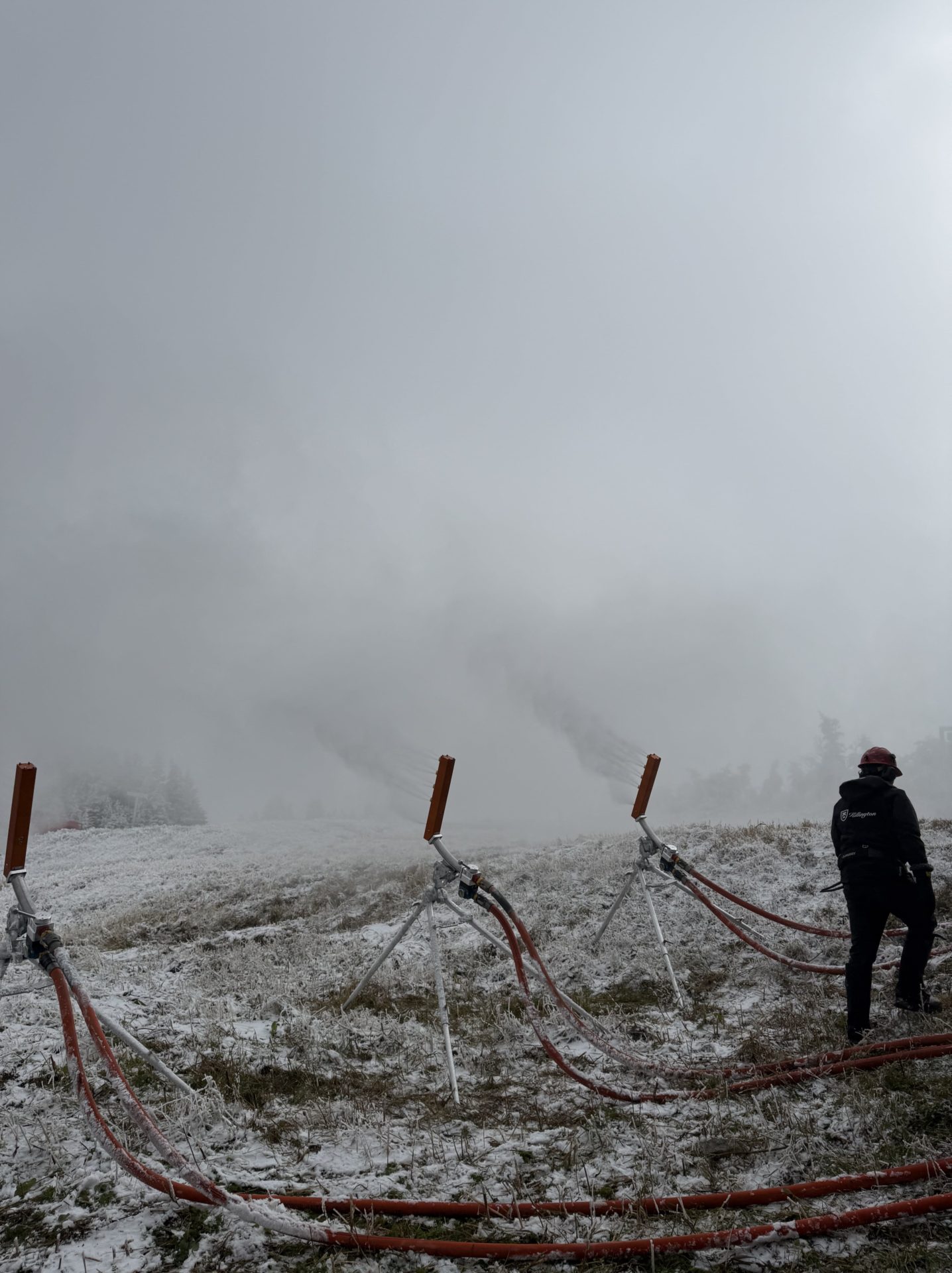
The new ownership group plans to continue upgrading its snowcat fleet to environmentally friendly and more efficient equipment by purchasing three new vehicles a year to replace older, less efficient ones. These plans were interrupted by the Pandemic. Currently, the fleet has five snowcats with snow depth technology which allows for targeted snowmaking to reinforce areas that need it without having to blow snow on the entire trail.
Killington Grooming Fleet Purchases
| Fiscal Year | Snowcats Purchased |
| FY 19 | 3 |
| FY 20 | 0 |
| FY 21 | 4 |
| FY 22 | 1 |
| FY 23 | 3 |
| FY 24 | 2 |
With the success and continued growth of mountain biking, Killington is planning a trail expansion in the summer of 2025. The permit process is currently underway with the State for the addition of a new trail serviced by the Ramshead Express Quad. This portion of the expansion will total $300,000. “The goal is to provide more options for riders to mix and match sections of different trails to add more variety to that side of the Bike Park,” says Bike Park manager Taylor Zink. “We hope to break ground in the spring and have some sections of the new trail open before the season ends. We have a lot of opportunity for future trail expansion; it’s very exciting,” Zink adds.

The Killington Cup Giant Slalom and Slalom races have drawn upwards of 40,000 fans throughout the two-day event making it one of the most well-attended race series on the Women’s Tour each year. “It’s always a thrill to kick off the alpine season with the Stifel Killington Cup, especially in a World Championship year! Killington is proud to host the best in the world on Superstar year after year and we’re looking forward to another exciting weekend of racing action,” states Amy Lamarie, Director of Marketing, for Killington. The status of the 2025 event is still to be determined as the resort finalizes the construction timeline for the new Superstar lift.

American ski racing star Mikaela Shiffrin has won five Killington Cup Slaloms and will be back in 2024 seeking both her sixth Slalom victory and her first Giant Slalom victory on the Superstar race course. Based on early season results at the Sölden Giant Slalom in Austria, American fans can look forward to seeing Paula Moltzan, Nina O’Brien, and Katie Hensien, also compete for the podium.
In response to the success of the World Cup at Killington and given the intense interest in ski racing in Vermont, Phil Gross has helped to found the Killington World Cup Foundation (KWCF), which is dedicated to promoting ski racing and supporting athletes at the highest level. The Foundation actively engages with local communities, providing grants for youth development through ski racing programs and supporting ski educational initiatives. The Foundation’s Mission is “to benefit local and regional youth development programs and to support the Women’s World Cup at Killington.” KWCF provides grants to support winter sports infrastructure and access to winter sports in the Northeast, to create lifelong participants in the sport.
KWCF achievements:
- Over 10,000 participants in funded Grant programs
- 35% of participants were new to the program
- 30% of participants had never skied before
- KWCF gave grants to 31 different non-profits
- KWCF gave grants in eight states
- Combined with matching funds and multi-year grant commitments, KWCF has brought more than two million dollars in resources to the winter sports infrastructure in the region.
“It is critical to support these programs to encourage and grow participants in winter sports and to support the dreams and aspirations of young athletes. The women on the World Cup circuit are incredible role models and we are excited to have their visit to Killington for the World Cup lead to an opportunity to grow and enhance winter sports programs in the region.”
— Phill Gross, U.S. Ski & Snowboard trustee and KWCF Board Member.
The sale of Killington and Pico to a local group of investors is an anomaly in this era of ski area consolidation under larger ownership groups like Alterra and Vail. Local ownership is committed to making both Killington and Pico premier destinations in the Northeast. With its off-season attractions along with the construction of the Six Peaks Ski Village, Killington is poised to continue its growth over the next decade. New lodges, upgraded lifts, and efficient snowmaking, combined with a dedicated core of skiers and riders, ensure that this next chapter of Killington’s history will be one to watch.